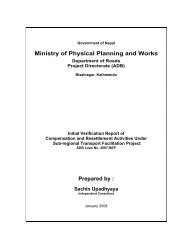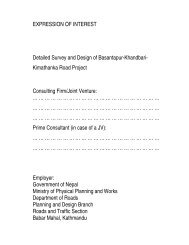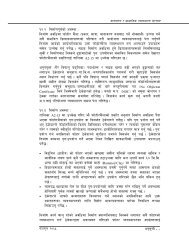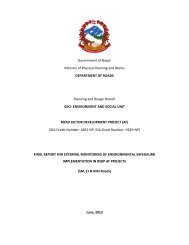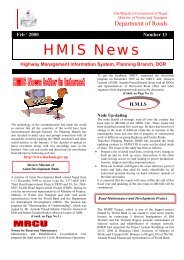Environmental & Social Management Framework - About ...
Environmental & Social Management Framework - About ...
Environmental & Social Management Framework - About ...
Create successful ePaper yourself
Turn your PDF publications into a flip-book with our unique Google optimized e-Paper software.
<strong>Environmental</strong> and <strong>Social</strong> <strong>Management</strong> <strong>Framework</strong>4.2.1 Generation of EmploymentOne of the major direct beneficial impacts is the creation of employment. Thesub-projects would require a large number of skilled and unskilled manpower. Forexample, for Mirchaiya-Katari-Sunkoshi Road, assuming 18 months of theconstruction period, about 100 skilled, 850 unskilled labours will be requiredevery day which gives the ample opportunity for the local people to work.. Thesocio-economic information indicates that about 70 percent of the local peopleare economically active and most of them out-migrate during the agriculture offseason.As the road upgrading works require labourers, it is likely that they will prefer towork in these projects to stay close to their families. The project shall provideadequate training for masonry works and carpentering to increase the skills oflocal work candidates. Among the key requirements for employment of locallabourers are:• No gender disparity in terms of number of unskilled workers and wages forequal type of work,• Preference to disadvantaged ad vulnerable local groups,• Strict avoidance of children (up to age 16) work, and• Scheduling the construction works as much as feasible during the agriculturaloff-season to enable local people to become engaged, and to bridge thelenient/income-low season to secure food sufficiency.4.2.2 Opportunities of New Income Generating Activities (IGAs)The construction activities will not only increase the income sources of the localpeople, but will open opportunities for additional business opportunities such asthe establishment of local tea stalls and ‘dal bhat’ shops. As a result, a significantamount of cash from the project works will be channelled into the local economyand will generally foster the development off other micro-enterprises.Once an all-year road access is available, local farmers may be encouraged tostart additional or other small scale agro-industries, cold storage, juice andcandy, ketchup, bakery etc. When completed, improved road connectivity willbring about opportunities for the promotion of trade and business. All weatherroad facilities will enhance the trade and business because of round the yearaccess and reduced transportation cost. The flow of goods from and to theproject influence area will be continuous. Local products could be transportedoutside markets at low cost, thereby benefiting the producers.The local agricultural and horticulture products (citrus, apple, tropical fruits) thatuse to go rotten and waste previously can be processed and transported. Thusan improved road linkage with other markets opens potential opportunities for theproduction of off-season vegetables.In this context, however, care must be taken to channel IGAs to ensure thatbenefits are equally distributed among the local communities. In Nepal, quiteoften migrants or outsiders tend to overtake the locals in terms of realizingbenefits from the new development much faster and at costs of thelocal/disadvantaged communities. Therefore it is recommended to install effectivesocial mobilization from NGOs to encourage local people to tap the newopportunities, which includes also the creation of credit facilities, support fromgovernment agencies, extension services as well as support from the roadprogram itself.April 2007 Chapter 4-3



![j:6 ]zg cfof ]hgf](https://img.yumpu.com/51286794/1/190x245/j6-zg-cfof-hgf.jpg?quality=85)

![x'nfsL /fhdfu { cfof ]hgf](https://img.yumpu.com/50581959/1/190x245/xnfsl-fhdfu-cfof-hgf.jpg?quality=85)
